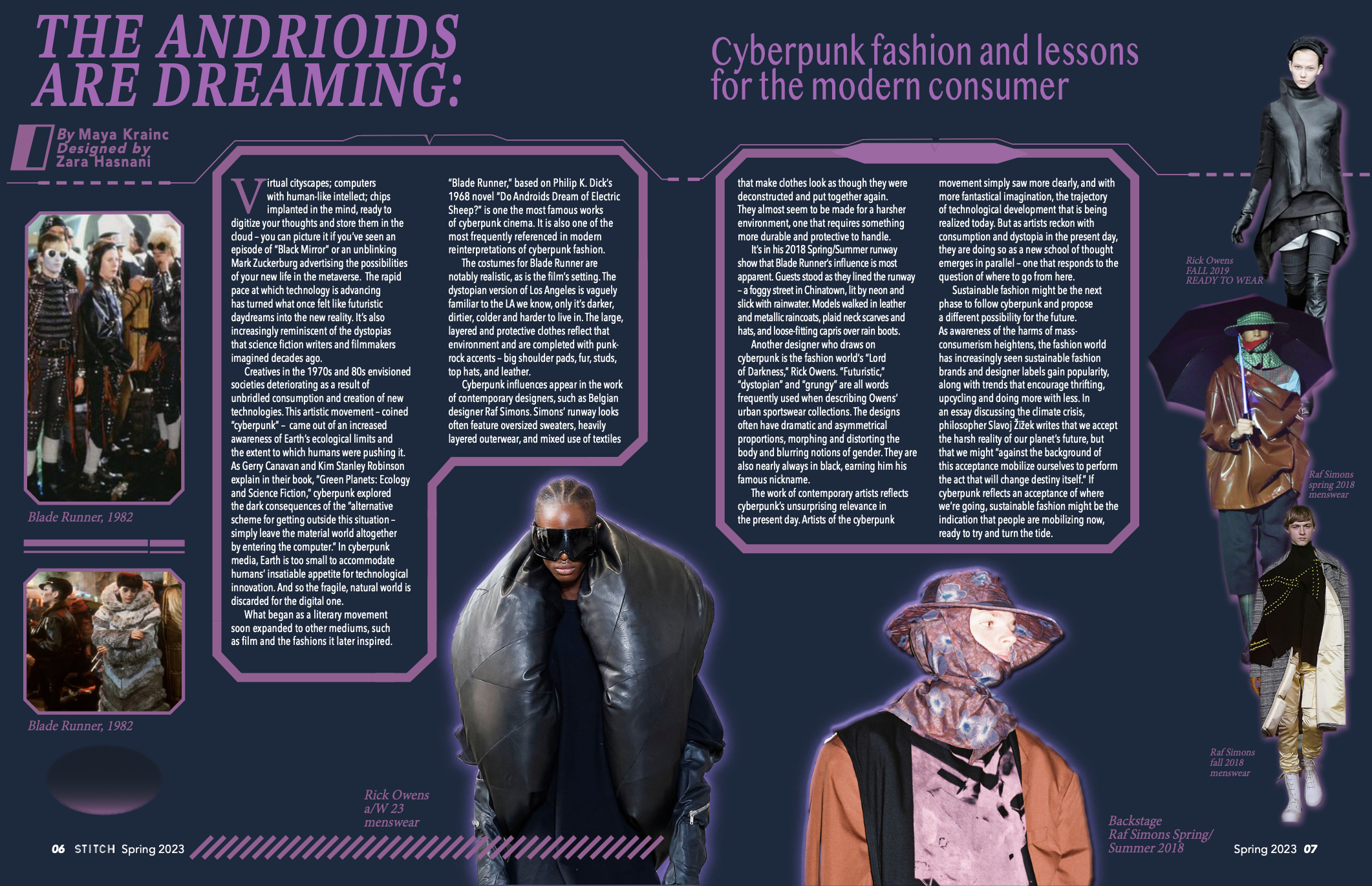The Androids are Dreaming: Cyberpunk Fashion and Lessons For the Modern Consumer
Virtual cityscapes; computers with human-like intellect; chips implanted in the mind, ready to digitize your thoughts and store them in the cloud – you can picture it if you’ve seen an episode of “Black Mirror” or an unblinking Mark Zuckerburg advertising the possibilities of your new life in the metaverse. The rapid pace at which technology is advancing has turned what once felt like futuristic daydreams into the new reality. It’s also increasingly reminiscent of the dystopias that science fiction writers and filmmakers imagined decades ago.
Creatives in the 1970s and 80s envisioned societies deteriorating as a result of unbridled consumption and creation of new technologies. This artistic movement – coined “cyberpunk” – came out of an increased awareness of Earth’s ecological limits and the extent to which humans were pushing it. As Gerry Canavan and Kim Stanley Robinson explain in their book, “Green Planets: Ecology and Science Fiction,” cyberpunk explored the dark consequences of the “alternative scheme for getting outside this situation – simply leave the material world altogether by entering the computer.” In cyberpunk media, Earth is too small to accommodate humans’ insatiable appetite for technological innovation. And so the fragile, natural world is discarded for the digital one.
What began as a literary movement soon expanded to other mediums, such as film and the fashions it later inspired. “Blade Runner,” based on Philip K. Dick’s 1968 novel “Do Androids Dream of Electric Sheep?” is one the most famous works of cyberpunk cinema. It is also one of the most frequently referenced in modern reinterpretations of cyberpunk fashion. he costumes for Blade Runner are notably realistic, as is the film’s setting. The dystopian version of Los Angeles is vaguely familiar to the LA we know, only it’s darker, dirtier, colder and harder to live in. The large, layered and protective clothes reflect that environment and are completed with punk- rock accents – big shoulder pads, fur, studs, top hats, and leather.
Cyberpunk influences appear in the work of contemporary designers, such as Belgian designer Raf Simons. Simons’ runway looks often feature oversized sweaters, heavily layered outerwear, and mixed use of textiles that make clothes look as though they were deconstructed and put together again. They almost seem to be made for a harsher environment, one that requires something more durable and protective to handle.
It’s in his 2018 Spring/Summer runway show that Blade Runner’s influence is most apparent. Guests stood as they lined the runway – a foggy street in Chinatown, lit by neon and slick with rainwater. Models walked in leather and metallic raincoats, plaid neck scarves and hats, and loose-fitting capris over rain boots.
Another designer who draws on cyberpunk is the fashion world’s “Lord of Darkness,” Rick Owens. “Futuristic,” “dystopian” and “grungy” are all words frequently used when describing Owens’ urban sportswear collections. The designs often have dramatic and asymmetrical proportions, morphing and distorting the body and blurring notions of gender. They are also nearly always in black, earning him his famous nickname. The work of contemporary artists reflects cyberpunk’s unsurprising relevance in the present day. Artists of the cyberpunk movement simply saw more clearly, and with more fantastical imagination, the trajectory
of technological development that is being realized today. But as artists reckon with consumption and dystopia in the present day, they are doing so as a new school of thought emerges in parallel – one that responds to the question of where to go from here.
Sustainable fashion might be the next phase to follow cyberpunk and propose a different possibility for the future. As awareness of the harms of mass- consumerism heightens, the fashion world has increasingly seen sustainable fashion brands and designer labels gain popularity, along with trends that encourage thrifting, upcycling and doing more with less. In an essay discussing the climate crisis, philosopher Slavoj Žižek writes that we accept the harsh reality of our planet’s future, but that we might “against the background of this acceptance mobilize ourselves to perform the act that will change destiny itself.” If cyberpunk reflects an acceptance of where we’re going, sustainable fashion might be the indication that people are mobilizing now, ready to try and turn the tide.

